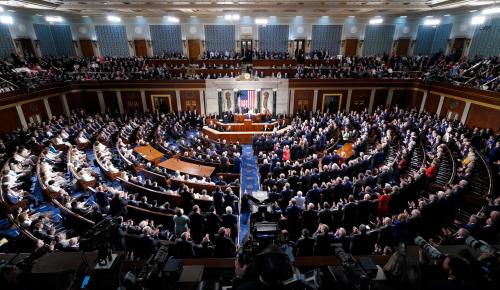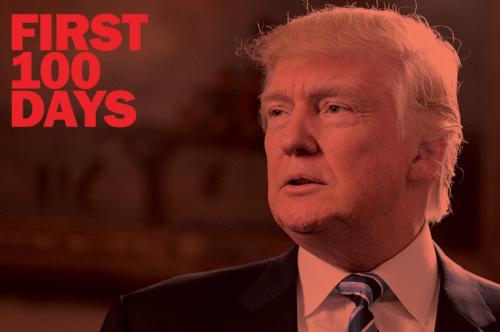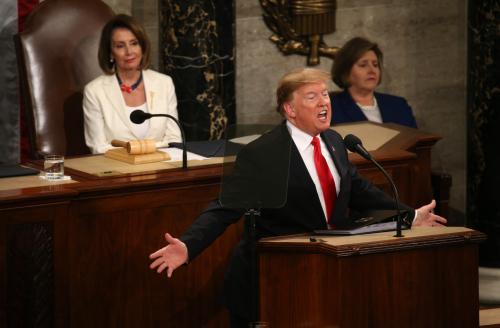This post is part of series by Brookings experts on Trump’s 1st State of the Union.
By the time President Trump delivered his first State of the Union address this evening, much of the suspense had been drained away. As numerous White House staffers had foreshadowed, the tone resembled his speech a year ago to a joint session of Congress rather than his combative and dystopian inaugural address. He stressed the need—and his desire—for unity. He invoked patriotism and the American flag. It ended with a Reaganesque salute to American exceptionalism and exceptional Americans. It is, he declared, “the people who are making America great again.” Discussing immigration reform, he declared that “Americans are dreamers, too.”
It was, in short, a fairly normal State of the Union, festooned with distinctive Trump ornamentation. As all presidents do, he took credit for what went right during his first year in office. Looking forward, he laid out his agenda and invoked the ideal of bipartisanship—as most presidents do.
America may not be great again just yet, but the president clearly believes that he has moved us from American carnage to American comeback in just one year. By his own standards, he was entitled to take a victory lap tonight. The economy is growing vigorously. Wages are finally rising. Corporations are reinvesting in America. The energy sector is thriving, and manufacturing jobs are increasing.
The president cited achievements such as a massive tax cut, significant deregulation, and the confirmation of numerous judges as well as a very conservative Supreme Court justice. American and allied forces dealt a knockout blow to the “caliphate” ISIS had proclaimed. Although the drive to repeal the Affordable Care Act fell short, he did manage to secure the repeal of the requirement that individuals purchase health insurance, the least popular element of the ACA.
Notably, few Republicans of any stripe insisted on fiscal prudence, during the campaign or afterward, and those who did found reason to subordinate their concerns to other considerations. Not surprisingly, the tax bill increased the deficit by $1 trillion over the next decade, and the likely resolution of the budget stalemate—more money for both defense and domestic spending—will increase it still more.
A fuller accounting than President Trump offered would have underscored the respects in which he fell short of his own goals. During his campaign, he railed against the trade deficit. But during 2017, the deficit rose—overall, and also with China and Mexico. His effort to restrict the flow of immigrants and refugees through administrative action stumbled over sloppy staff work and legal obstacles. Mexico refused to pay for the wall and shows no signs of changing its mind. After months of contradictory signals, he reluctantly reaffirmed the mutual defense clause of the NATO charter—the pillar of the liberal international order in Europe and beyond.
During the presidential campaign of 2016, it was often said that Trump had carried out a hostile takeover of the Republican Party. In retrospect, it looks more like a business transaction. The Trump forces accepted the agendas of the social conservatives—hard-right judges, school choice, an expansive view of religious liberty, opposition to abortion—and of economic conservatives—tax cuts and deregulation. In return, these factions of the party’s base agreed not to oppose Trump’s populist trifecta of immigration restrictions, tougher trade treaties, and an America First foreign policy that rejected the premises of liberal internationalism.
In the first year of his presidency, Trump kept his side of the deal. But the agenda he announced in his speech tonight challenges establishment Republicans to keep theirs. The business community does not favor the radical reduction of legal immigration the president proposed in his plan to give legal status to DACA-eligible immigrants, and they are nervous about a negotiating stance that could produce the collapse of NAFTA. Limited government conservatives do not support significant new federal investment in infrastructure; deficit hawks will resist the large increase in military spending the president wants; and internationalist-minded Republican senators will continue to push back against American First rhetoric that could destabilize traditional alliances. It remains to be seen whether the president can achieve his proposed $1.5 trillion boost in infrastructure spending without running up against fiscal limits and conservative resistance.
State of the Union addresses are political as well as legislative documents, especially in election years. As of now, anyway, the accomplishments of Trump’s first year do not command majority support. Most Americans believe that the tax bill does more for large corporations and the wealthy than for small businesses and middle-class families. (In describing the bill, notably, the president stressed its advantages for families and said little about the large rate cuts for corporations.) Despite his emphasis on cutting regulations, a majority of Americans believe that they are needed to check wrongdoing and protect the public interest. The measures that thrill social conservatives antagonize the majority of Americans who see these measures as narrow and intolerant. Along with concerns about Trump’s demeanor and conduct, his agenda helps explain why he ended his first year in office with record-low approval ratings for a president at this early stage of his presidency.
This is a problem for the entire Republican Party. Although Trump will not be on the ballot this November, history suggests the midterm elections—especially after the president’s first two years—are referenda on the president. Unless the president’s public approval rises significantly during the next nine months, Republican control of the House will be in jeopardy, and even their Senate majority will be in play.
Key features of the president’s second-year agenda will not do much to remedy the situation. Not only do establishment Republicans view them with misgivings, but so do most Americans. Solid majorities believe that immigrants and trade treaties—including NAFTA—strengthen the United States. An equally solid majority opposes the construction of the president’s famous wall along the southern border. Immigration and trade rank near the bottom to the public’s to-do list. The issues that energized Trump’s base in 2016 will not help him build majority support this year.
Trump spoke at length about what he described as his “down-the-middle compromise” proposal on immigration reform and urged bipartisanship. Unfortunately, few Democrats view the president’s proposal as fair, especially the part of the plan that would cut legal immigration by almost half. To achieve his goal, the president will have to settle for a narrower plan that combines DACA relief and with robust enforcement and border security.
As the occasion demands, Trump dealt with defense and foreign policy. He called for stepped-up military spending and the renewal of our nuclear arsenal. To deal with dangerous detainees, he pledged to keep Guantanamo Bay’s detention center open. He underscored new rules of engagement for American fighting in Afghanistan. He reminded his listeners that he had recognized Jerusalem as Israel’s capital and recommended legislation that could cut foreign aid for nations who voted against this move in the United States. He called for major changes in the Iran nuclear deal. In a tough passage on North Korea’s nuclear threat, Trump pledged not to repeat the mistakes of prior administrations that had led to the current impasse, but offered no new details about how to break it.
Although the Republican Party is facing strong headwinds in 2018, it has some grounds for hope. As Americans experience the effects of the tax bill, its popularity may rise. (Democrats harbored similar hopes for the Affordable Care Act.) A strengthening economy could redound to the credit of the incumbent majority.
Congressional Republicans could improve their prospects by swallowing their fiscal and ideological misgivings and going along with Trump’s infrastructure proposals. Americans disagree about many things. But proliferating potholes, collapsing bridges, crumbling dams, crashing trains, and eroding airports have convinced the public that it is high time to invest in the basics on which a civilized society depends. Similarly, the people endorse Trump’s pledge to reduce the price of prescription drugs, fight the opioid epidemic, and institute paid family leave. An outbreak of common sense among Republican elected officials might persuade voters to give them another chance.
History suggests that, by themselves, State of the Union addresses rarely move the political needle for long. Much depends on the ability of the White House to sustain the themes and policies for the months needed to convince a skeptical or inattentive public that something real is happening. In the current context, even more depends on Trump’s ability to restrain himself from stepping on his own message. No matter how good the reviews of his speech may be, one ill-judged tweet about the Mueller investigation could wipe them away—and shift the focus back to issues the president would be well advised to avoid.










Commentary
Trump cites achievements, calls for unity in 1st State of the Union
January 30, 2018